
Illustrative Math Alignment: Grade 6 Unit 9
Putting it All Together
Lesson 1: Fermi Problems
Use the following Media4Math resources with this Illustrative Math lesson.
| Thumbnail Image | Title | Body | Curriculum Topics |
|---|---|---|---|
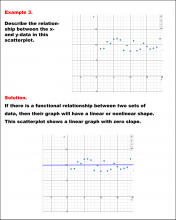
|
Math Example--Charts, Graphs, and Plots--Analyzing Scatterplots: Example 3 | Math Example--Charts, Graphs, and Plots-- Analyzing Scatterplots: Example 3
In this set of math examples, analyze the behavior of different scatterplots. This includes linear and quadratic models. |
Data Analysis |
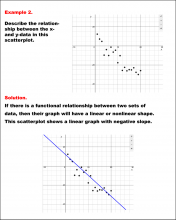
|
Math Example--Charts, Graphs, and Plots--Analyzing Scatterplots: Example 2 | Math Example--Charts, Graphs, and Plots-- Analyzing Scatterplots: Example 2
In this set of math examples, analyze the behavior of different scatterplots. This includes linear and quadratic models. |
Data Analysis |
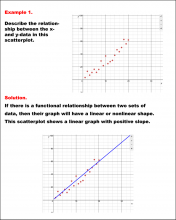
|
Math Example--Charts, Graphs, and Plots--Analyzing Scatterplots: Example 1 | Math Example--Charts, Graphs, and Plots-- Analyzing Scatterplots: Example 1
In this set of math examples, analyze the behavior of different scatterplots. This includes linear and quadratic models. |
Data Analysis |
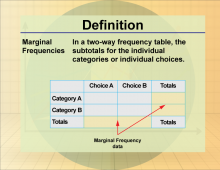
|
Definition--Statistics and Probability Concepts--Marginal Frequencies | Marginal FrequenciesTopicStatistics and Probability DefinitionMarginal frequencies are the totals of rows or columns in a contingency table, representing the sum of joint frequencies for each category. DescriptionMarginal frequencies provide insight into the overall distribution of each variable in a dataset. They are crucial in fields like epidemiology, where understanding the marginal distribution of diseases can inform public health strategies. For students, comprehending marginal frequencies is essential for summarizing data and drawing conclusions about the prevalence of certain characteristics within a population. |
Data Analysis |
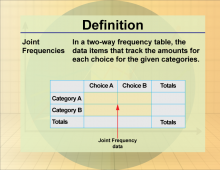
|
Definition--Statistics and Probability Concepts--Joint Frequencies | Joint FrequenciesTopicStatistics and Probability DefinitionJoint frequencies refer to the counts of occurrences for combinations of two categorical variables. DescriptionIn statistics, joint frequencies are used to analyze the relationship between two categorical variables, often displayed in a contingency table. This analysis is vital in fields such as market research, where understanding the joint distribution of consumer preferences can inform product development. For students, learning about joint frequencies is important for interpreting data from surveys and experiments, allowing them to explore relationships between variables effectively. |
Data Analysis |
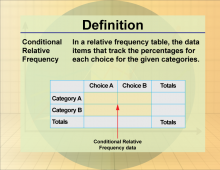
|
Definition--Statistics and Probability Concepts--Conditional Relative Frequency | Conditional Relative FrequencyTopicStatistics and Probability DefinitionConditional relative frequency is the ratio of the frequency of a subset of data to the frequency of a condition. DescriptionConditional relative frequency is crucial in analyzing categorical data, helping to understand the distribution of data under specific conditions. For example, the frequency of students who pass a test given they have attended all classes is a conditional relative frequency. Understanding this concept helps students interpret data in surveys and experiments more accurately. |
Data Analysis |
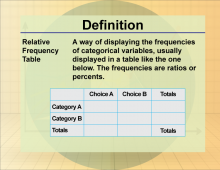
|
Definition--Statistics and Probability Concepts--Relative Frequency Table | Relative Frequency TableTopicStatistics and Probability DefinitionA relative frequency table displays the proportion of total occurrences for each category of data. DescriptionRelative frequency tables are important in statistics as they summarize data in a way that makes it easy to analyze proportions and patterns within datasets. These tables allow for quick comparisons of different categories based on their frequency relative to the total. |
Data Analysis |

|
Math Example--Charts, Graphs, and Plots--Graphs of Categorical Data--Example 6 | Math Example--Charts, Graphs, and Plots-- Graphs of Categorical Data--Example 6
In this set of math examples, analyze the behavior of different scatterplots. This includes linear and quadratic models. |
Data Analysis |

|
Math Example--Charts, Graphs, and Plots--Graphs of Categorical Data--Example 5 | Math Example--Charts, Graphs, and Plots-- Graphs of Categorical Data--Example 5
In this set of math examples, analyze the behavior of different scatterplots. This includes linear and quadratic models. |
Data Analysis |

|
Math Example--Charts, Graphs, and Plots--Graphs of Categorical Data--Example 4 | Math Example--Charts, Graphs, and Plots-- Graphs of Categorical Data--Example 4
In this set of math examples, analyze the behavior of different scatterplots. This includes linear and quadratic models. |
Data Analysis |
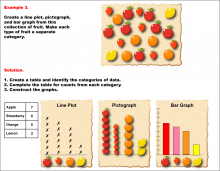
|
Math Example--Charts, Graphs, and Plots--Graphs of Categorical Data--Example 3 | Math Example--Charts, Graphs, and Plots-- Graphs of Categorical Data--Example 3
In this set of math examples, analyze the behavior of different scatterplots. This includes linear and quadratic models. |
Data Analysis |
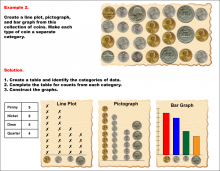
|
Math Example--Charts, Graphs, and Plots--Graphs of Categorical Data--Example 2 | Math Example--Charts, Graphs, and Plots-- Graphs of Categorical Data--Example 2
In this set of math examples, analyze the behavior of different scatterplots. This includes linear and quadratic models. |
Data Analysis |
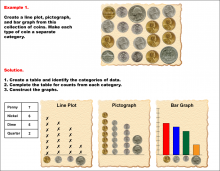
|
Math Example--Charts, Graphs, and Plots--Graphs of Categorical Data--Example 1 | Math Example--Charts, Graphs, and Plots-- Graphs of Categorical Data--Example 1
In this set of math examples, analyze the behavior of different scatterplots. This includes linear and quadratic models. |
Data Analysis |

|
Video Transcript: Measures of Central Tendency: Mean of a Probability Distribution | Video Transcript: Measures of Central Tendency: Mean of a Probability Distribution
This is the transcript for the video entitled, "Video Tutorial: Measures of Central Tendency: Mean of a Probability Distribution." This is part of a collection of video transcripts for the video tutorial series on Measures of Central Tendency. To see the complete collection of transcripts, click on this link. Note: The download is a PDF file. Video Transcript LibraryTo see the complete collection of video transcriptsy, click on this link. |
Data Analysis and Data Gathering |
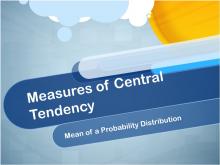
|
Video Tutorial: Measures of Central Tendency: Mean of a Probability Distribution | Video Tutorial: Measures of Central Tendency: Mean of a Probability Distribution
TopicMeasures of Central Tendency DescriptionThis section introduces the mean of probability distributions, also known as expected value, showing its calculation and interpretation in scenarios like dice rolls and coin flips. Key terms include mean, probability distribution, expected value, and weighted mean. |
Data Analysis and Data Gathering |

|
Video Transcript: Measures of Central Tendency: Sample Mean | Video Transcript: Measures of Central Tendency: Sample Mean
This is the transcript for the video entitled, "Video Tutorial: Measures of Central Tendency: Sample Mean." This is part of a collection of video transcripts for the video tutorial series on Measures of Central Tendency. To see the complete collection of transcripts, click on this link. Note: The download is a PDF file. Video Transcript LibraryTo see the complete collection of video transcriptsy, click on this link. |
Data Analysis and Data Gathering |
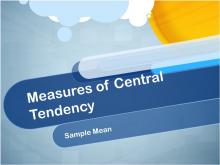
|
Video Tutorial: Measures of Central Tendency: Sample Mean | Video Tutorial: Measures of Central Tendency: Sample Mean
TopicMeasures of Central Tendency DescriptionThe video explains the sample mean and standard error, illustrating how they estimate population characteristics. Examples include trout lengths, macaw wingspans, and elephant weights. Key terms include sample mean, standard error, population mean, and summation. |
Data Analysis and Data Gathering |

|
Video Transcript: Measures of Central Tendency: The Mean and Normally Distributed Data | Video Transcript: Measures of Central Tendency: The Mean and Normally Distributed Data
This is the transcript for the video entitled, "Video Tutorial: Measures of Central Tendency: The Mean and Normally Distributed Data." This is part of a collection of video transcripts for the video tutorial series on Measures of Central Tendency. To see the complete collection of transcripts, click on this link. Note: The download is a PDF file. Video Transcript LibraryTo see the complete collection of video transcriptsy, click on this link. |
Data Analysis and Data Gathering |
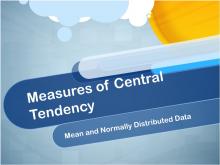
|
Video Tutorial: Measures of Central Tendency: The Mean and Normally Distributed Data | Video Tutorial: Measures of Central Tendency: The Mean and Normally Distributed Data
TopicMeasures of Central Tendency DescriptionThis video examines the mean in normally distributed data, linking it to standard deviation and probabilities. Examples include batting averages, heights, and shoe sizes, emphasizing normal distribution properties. Key terms include mean, normal distribution, standard deviation, and probabilities. |
Data Analysis and Data Gathering |

|
Video Transcript: Measures of Central Tendency: Finding the Mode of a Data Set | Video Transcript: Measures of Central Tendency: Finding the Mode of a Data Set
This is the transcript for the video entitled, "Video Tutorial: Measures of Central Tendency: Finding the Mode of a Data Set." This is part of a collection of video transcripts for the video tutorial series on Measures of Central Tendency. To see the complete collection of transcripts, click on this link. Note: The download is a PDF file. Video Transcript LibraryTo see the complete collection of video transcriptsy, click on this link. |
Data Analysis and Data Gathering |
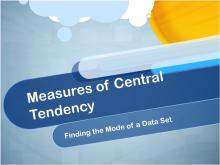
|
Video Tutorial: Measures of Central Tendency: Finding the Mode of a Data Set | Video Tutorial: Measures of Central Tendency: Finding the Mode of a Data Set
TopicMeasures of Central Tendency DescriptionThis section focuses on the mode, the most frequent value in a data set, and its applications in dice rolls, beverage ratings, and color preferences. It compares mode with mean and median, highlighting its utility in categorical data. Key terms include mode, frequency, and categorical data. |
Data Analysis and Data Gathering |

|
Video Transcript: Measures of Central Tendency: Weighted Mean | Video Transcript: Measures of Central Tendency: Weighted Mean
This is the transcript for the video entitled, "Video Tutorial: Measures of Central Tendency: Weighted Mean." This is part of a collection of video transcripts for the video tutorial series on Measures of Central Tendency. To see the complete collection of transcripts, click on this link. Note: The download is a PDF file. Video Transcript LibraryTo see the complete collection of video transcriptsy, click on this link. |
Data Analysis and Data Gathering |
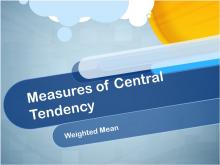
|
Video Tutorial: Measures of Central Tendency: Weighted Mean | Video Tutorial: Measures of Central Tendency: Weighted Mean
TopicMeasures of Central Tendency DescriptionThe video introduces the weighted mean for data sets with different item frequencies, using examples like cylinder heights, kettlebell weights, and daycare ages. It compares weighted means to medians to show their practical applications. Key terms include weighted mean, weights, and frequency. |
Data Analysis and Data Gathering |

|
Video Transcript: Measures of Central Tendency: Finding the Median of a Data Set | Video Transcript: Measures of Central Tendency: Finding the Median of a Data Set
This is the transcript for the video entitled, "Video Tutorial: Measures of Central Tendency: Finding the Median of a Data Set." This is part of a collection of video transcripts for the video tutorial series on Measures of Central Tendency. To see the complete collection of transcripts, click on this link. Note: The download is a PDF file. Video Transcript LibraryTo see the complete collection of video transcriptsy, click on this link. |
Data Analysis and Data Gathering |
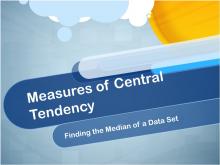
|
Video Tutorial: Measures of Central Tendency: Finding the Median of a Data Set | Video Tutorial: Measures of Central Tendency: Finding the Median of a Data Set
TopicMeasures of Central Tendency DescriptionThis segment discusses the median, another measure of central tendency, focusing on its calculation by ordering data and finding the middle value. Examples include test scores, basketball player heights, and family ages, highlighting scenarios where the median differs from the mean. Key terms include median, middle value, and ordering. |
Data Analysis and Data Gathering |

|
Video Transcript: Measures of Central Tendency: Finding the Mean of a Data Set II | Video Transcript: Measures of Central Tendency: Finding the Mean of a Data Set II
This is the transcript for the video entitled, "Video Tutorial: Measures of Central Tendency: Finding the Mean of a Data Set II." This is part of a collection of video transcripts for the video tutorial series on Measures of Central Tendency. To see the complete collection of transcripts, click on this link. Note: The download is a PDF file. Video Transcript LibraryTo see the complete collection of video transcriptsy, click on this link. |
Data Analysis and Data Gathering |
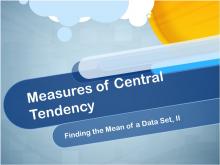
|
Video Tutorial: Measures of Central Tendency: Finding the Mean of a Data Set II | Video Tutorial: Measures of Central Tendency: Finding the Mean of a Data Set II
TopicMeasures of Central Tendency DescriptionThe video explores calculating the mean with data sets including negative numbers, like temperatures in Fairbanks and Fargo, and tide heights in Gloucester. It emphasizes the mean's robustness across varying data types and scenarios. Key terms include negative numbers, sum, and ratio. |
Data Analysis and Data Gathering |

|
Video Transcript: Measures of Central Tendency: Finding the Mean of a Data Set I | Video Transcript: Measures of Central Tendency: Finding the Mean of a Data Set I
This is the transcript for the video entitled, "Video Tutorial: Measures of Central Tendency: Finding the Mean of a Data Set I." This is part of a collection of video transcripts for the video tutorial series on Measures of Central Tendency. To see the complete collection of transcripts, click on this link. Note: The download is a PDF file. Video Transcript LibraryTo see the complete collection of video transcriptsy, click on this link. |
Data Analysis and Data Gathering |

|
Video Tutorial: Measures of Central Tendency: Finding the Mean of a Data Set I | Video Tutorial: Measures of Central Tendency: Finding the Mean of a Data Set I
TopicMeasures of Central Tendency DescriptionThis video introduces the mean as a measure of central tendency, explaining it as the sum of values divided by their count. Examples include calculating test scores, flamingo wingspans, and football punt lengths, demonstrating how the mean is applied to summarize data. Key terms include mean, average, sum, and ratio. |
Data Analysis and Data Gathering |
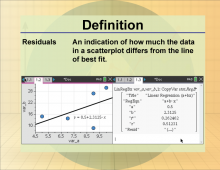
|
Definition--Statistics and Probability Concepts--Residuals | ResidualsTopicStatistics and Probability DefinitionResiduals are the differences between observed and predicted values in a dataset. DescriptionIn statistics, residuals are crucial for assessing the accuracy of predictions generated by statistical models. They represent the errors in prediction, providing insight into the model's performance and areas for potential improvement. |
Data Analysis |
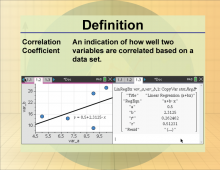
|
Definition--Statistics and Probability Concepts--Correlation Coefficient | Correlation CoefficientTopicStatistics and Probability DefinitionThe correlation coefficient is a measure that quantifies the degree to which two variables are related. |
Data Analysis |

|
Definition--Statistics and Probability Concepts--Two-Way Frequency Table | Two-Way Frequency TableTopicStatistics and Probability DefinitionA two-way frequency table displays the frequency of data points across two categorical variables. DescriptionTwo-way frequency tables are essential for analyzing the relationship between two categorical variables, often used in survey analysis to explore associations between different demographic factors. They help in identifying patterns and correlations within datasets. |
Data Analysis |
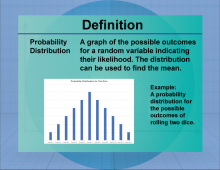
|
Definition--Measures of Central Tendency--Probability Distribution | Probability DistributionTopicStatistics DefinitionA probability distribution describes how the values of a random variable are distributed. DescriptionProbability distributions are fundamental in statistics, providing a mathematical function that gives the probabilities of occurrence of different possible outcomes for an experiment. They are used in various fields such as finance, science, and engineering to model uncertainty and variability. For instance, the normal distribution is a common probability distribution that describes many natural phenomena. |
Data Analysis |
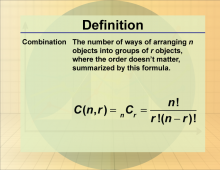
|
Definition--Statistics and Probability Concepts--Combination 1 | Combination 1TopicStatistics and Probability DefinitionA combination is a selection of items from a larger pool where order does not matter. DescriptionCombinations are used in probability to determine the number of ways to select items from a set, which is crucial in fields like cryptography and game theory. The formula for combinations is
where n is the total number of items, and r is the number of items to choose. |
Data Analysis |

|
Definition--Statistics and Probability Concepts--Permutation 1 | Permutation 1TopicStatistics and Probability DefinitionA permutation is an arrangement of items in a specific order. DescriptionPermutations are used in probability and combinatorics to determine the number of ways to arrange a set of items, which is crucial in fields like cryptography, where secure codes are generated. The formula for permutations is |
Data Analysis |
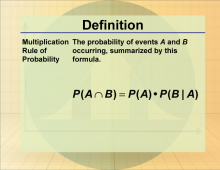
|
Definition--Statistics and Probability Concepts--Multiplication Rule of Probability | Multiplication Rule of ProbabilityTopicStatistics and Probability DefinitionThe multiplication rule of probability is used to find the probability of two independent events both occurring. DescriptionThe multiplication rule is essential in probability for calculating the likelihood of multiple independent events occurring together. This rule is applied in fields such as genetics, where the probability of inheriting multiple traits is determined. For students, understanding the multiplication rule is crucial for solving problems involving the probability of compound events and for developing a deeper understanding of probability theory. |
Data Analysis |
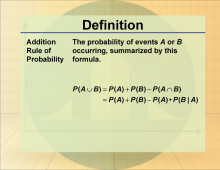
|
Definition--Statistics and Probability Concepts--Addition Rule of Probability | Addition Rule of ProbabilityTopicStatistics and Probability DefinitionThe Addition Rule of Probability is a key concept in statistics that helps in understanding the interaction between different events. DescriptionThe Addition Rule of Probability is crucial in the field of statistics because it allows us to make informed decisions based on the relationships between variables. For instance, in real-world applications, this concept is essential in various fields such as economics, social sciences, and health studies. Understanding how events affect each other can lead to better predictions and strategies. |
Data Analysis |
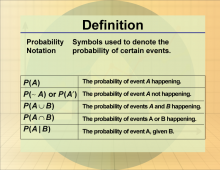
|
Definition--Statistics and Probability Concepts--Probability Notation | Probability NotationTopicStatistics and Probability DefinitionProbability notation is a standardized way of expressing probabilities. DescriptionProbability notation provides a concise language for defining and communicating probabilities in mathematics. It helps in avoiding confusion in statistical communication. Common symbols include P(A) for the probability of event A occurring. |
Data Analysis |
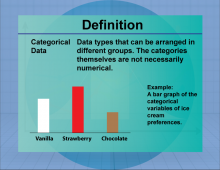
|
Definition--Measures of Central Tendency--Categorical Data | Categorical DataTopicStatistics DefinitionCategorical data refers to data that can be divided into specific categories or groups. DescriptionCategorical data is essential for organizing and analyzing information that falls into distinct categories, such as gender, race, or product type. This type of data is often used in market research, social sciences, and public health studies to identify patterns and relationships between groups. In mathematics, understanding categorical data is crucial for interpreting bar charts, pie charts, and frequency tables. |
Data Analysis |

|
Definition--Statistics and Probability Concepts--Bivariate Data | Bivariate DataTopicStatistics and Probability DefinitionBivariate data involves the analysis of two variables to determine relationships between them. DescriptionBivariate data is essential in statistics as it allows for the exploration of relationships between two variables, such as height and weight. This analysis is used in various fields, including economics, biology, and social sciences, to understand correlations and causations. For example, a scatter plot can be used to visually represent bivariate data, helping to identify trends or patterns. |
Data Analysis |
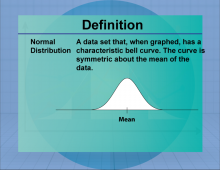
|
Definition--Measures of Central Tendency--Normal Distribution | Normal DistributionTopicStatistics DefinitionThe normal distribution is a measure of central tendency that provides an average representation of a set of data. DescriptionThe Normal Distribution is an important concept in statistics, used to summarize data effectively. In real-world applications, the Normal Distribution helps to interpret data distributions and is widely used in areas such as economics, social sciences, and research. |
Data Analysis |

|
Definition--Statistics and Probability Concepts--Causation | CausationTopicStatistics and Probability DefinitionCausation refers to the relationship between two events where one event is affected by the other. DescriptionCausation is a fundamental concept in statistics that distinguishes between correlation and causation. Understanding causation is vital in fields like medicine and social sciences to establish cause-effect relationships. For example, clinical trials are designed to establish causation between treatments and outcomes. Grasping causation is important for students to critically evaluate research findings and understand the implications of statistical analyses. |
Data Analysis |
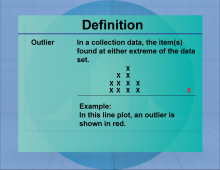
|
Definition--Measures of Central Tendency--Outlier | OutlierTopicStatistics DefinitionThe outlier is is an extreme value for a data set. DescriptionThe Outlier is an important concept in statistics. While it doesn't represent the average data set, it does set the range of extreme values in the data set. An outlier can be extremely large or small. In mathematics education, understanding outlier is crucial as it lays the foundation for more advanced statistical concepts. It allows students to grasp the significance of data analysis and interpretation. In classes, students often perform exercises calculating the mean of sets, which enhances their understanding of averaging techniques. |
Data Analysis |
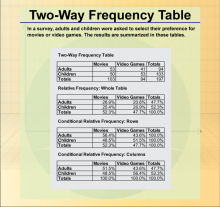
|
Math Clip Art--Statistics and Probability--Two-Way Frequency Table--2 | Math Clip Art--Statistics and Probability--Two-Way Frequency Table--2
This is part of a collection of math clip art images that show different statistical graphs and concepts, along with some probability concepts. |
Data Analysis |
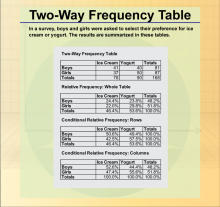
|
Math Clip Art--Statistics and Probability--Two-Way Frequency Table--1 | Math Clip Art--Statistics and Probability--Two-Way Frequency Table--1
This is part of a collection of math clip art images that show different statistical graphs and concepts, along with some probability concepts. |
Data Analysis |
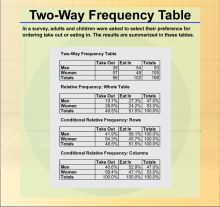
|
Math Clip Art--Statistics and Probability--Two-Way Frequency Table--3 | Math Clip Art--Statistics and Probability--Two-Way Frequency Table--3
This is part of a collection of math clip art images that show different statistical graphs and concepts, along with some probability concepts. |
Data Analysis |
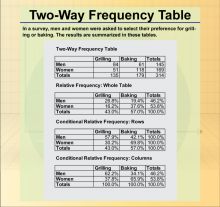
|
Math Clip Art--Statistics and Probability--Two-Way Frequency Table--5 | Math Clip Art--Statistics and Probability--Two-Way Frequency Table--5
This is part of a collection of math clip art images that show different statistical graphs and concepts, along with some probability concepts. |
Data Analysis |
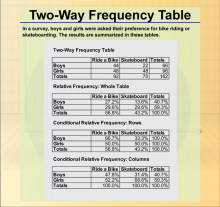
|
Math Clip Art--Statistics and Probability--Two-Way Frequency Table--6 | Math Clip Art--Statistics and Probability--Two-Way Frequency Table--6
This is part of a collection of math clip art images that show different statistical graphs and concepts, along with some probability concepts. |
Data Analysis |

|
Math Clip Art--Statistics and Probability--Two-Way Frequency Table--4 | Math Clip Art--Statistics and Probability--Two-Way Frequency Table--4
This is part of a collection of math clip art images that show different statistical graphs and concepts, along with some probability concepts. |
Data Analysis |
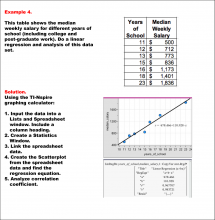
|
Math Example--Linear Function Concepts--Linear Data Model: Example 4 | Math Example--Linear Function Concepts--Linear Data Model: Example 4TopicLinear Functions |
Data Analysis |